metals: steel framing
1/80
There's no tags or description
Looks like no tags are added yet.
Name | Mastery | Learn | Test | Matching | Spaced |
|---|
No study sessions yet.
81 Terms
steel type:
cold formed steel
use case:
trusses/lighter weight framing & decking
steel type:
open web steel joist
use case:
floor support & trusses/lighter weight framing decking
steel type:
high strength, low alloy
use case:
beams and columns
steel type:
weathering steel
use case:
beams and columns
steel type:
wide flange
use case:
floor support & beams and columns
steel type:
stainless steel
use case:
corrosion resistant
steel type:
hss (hollow structural section)
use case:
beams and columns & trusses/lighter-weight framing
steel type:
cast iron
use case:
strongest in compression but most brittle
carbon content in iron alloy
greater proportions of carbon generally increase the hardness and brittleness of the iron alloy
carbon content in iron alloy graph
a. strong in tension/malleable
b. most commonly used for “structural steel”
c. strong in tension/compression (not prone to failure)
d. most brittle, prone to sudden failure
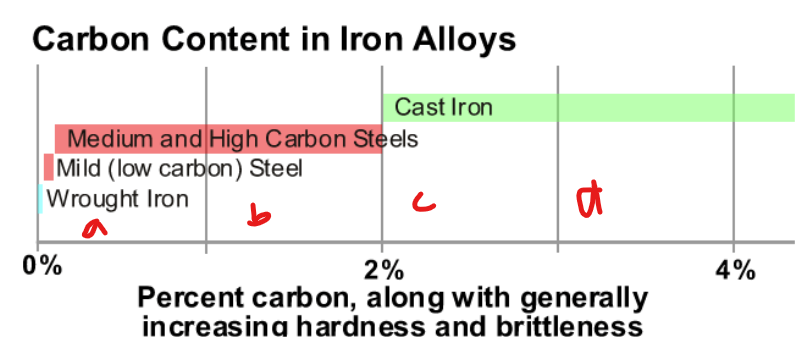
wrought iron
little or no carbon
strong in tension, weaker in compression
malleanle (easily shaped) and soft
mild steel (low carbon steel)
most common alloy for modern structural steel
not more than 0.3% carbon
small amounts of other metals improve strength, toughness, and other qualities
medium/high carbon steel
more than 0.3%, less than 2% carbon
strong in both tension and compression
ductile (not prone to sudden failure)
cast iron
2%-4% carbon
strong in compression
less strong in tension
brittle (vulnerable to sudden failure)
steelmaking
in a traditional steel mill, iron ore is the best raw ingredient
first, it is processed into molten iron in a blast furnace
then followed by conversion to steel in a second operation
steelmaking cont.
molten steel being tapped from an electric arc furnace into a vessel called a “ladle”
casting (steelmaking)
as the molten steel begins to solidify, it is cast into shapes ranging from plain rectangles or rounds to more complex cross sections, such as beam blanks, that approximate the shape of finished beam products
rolling mill
structural shapes are produced in a rolling mill
prior to rolling, the beam blanks are reheated to the necessary temp.
recycled content
about 25-35% recycled content
In North America, much of the structural steel is made from recycled scrap in mini mills using electric arc furnaces, converting scrap into new steel without needing to make iron from ore.
primary products are flat-rolled stock, such as steel decking and other sheet products
structural shapes
wide flange (w-shape): the most commonly used shape for beams and columns
channels, angles, tees: ofr trusses, lighter weight framing, and other miscell. uses
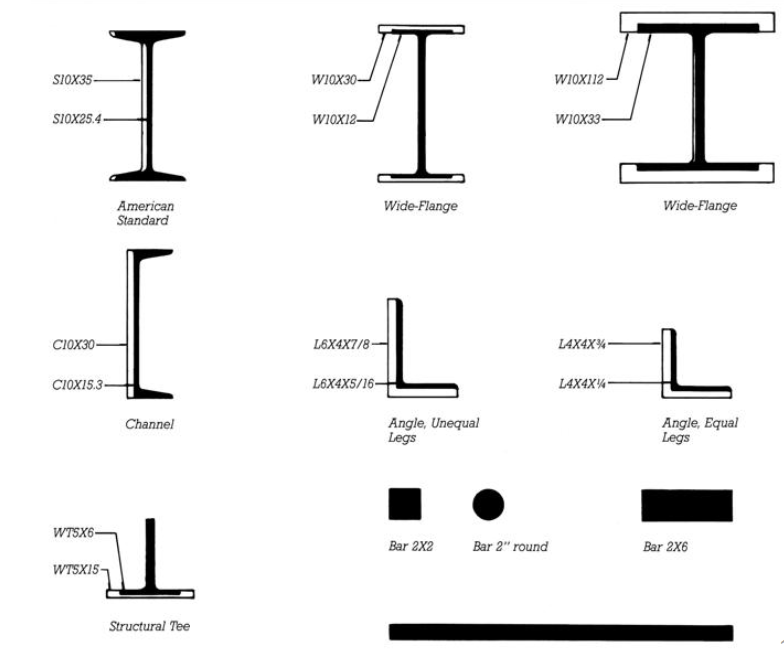
shape designation
W10×30
W: wide flange shape
10: nominal/theoretical depth (inches)
30: 30 lbs/lineal ft
wide flange shapes
taller more narrow profiles are
best for horizontally spanning
elements such as beams and
girdersthicker, more balanced (same
dimension both ways) used for
vertical spanning elements such
as columns.
aisc steel construction manual
dimensions page: dimensional data
properties page: shape properties related to structural stiffness and strength calculations
some exceptions in sizing
size designations are
nominal, not always an
accurate indication of
actual depth.a W14 x 873 is 23.6" deep!
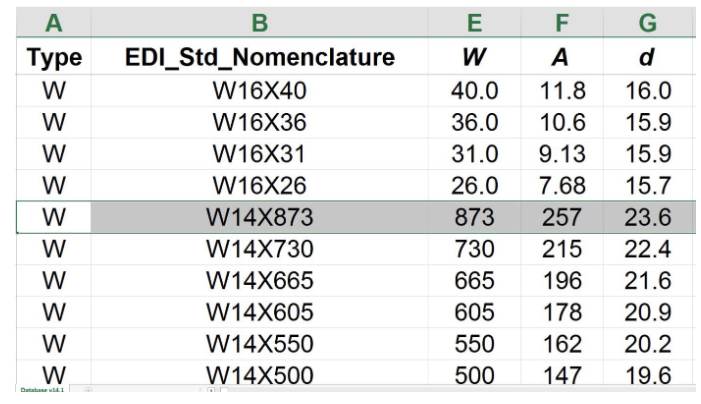
other shape designations
S: American Standard beam
(“I-beam”)MC: Miscellaneous channel
C: American Standard channel
L: Angle
WT: T-shape cut from W shape
HSS: hollow structural section
hollow structural sections (hss)
hollow square, rectangular,
round, and elliptical shapesare used for trusses, structurally efficient
column sections, and where
the simple external profile is
desirableExample designation:
HSS 8 x 8 x ½
8"x8"x½" wall thickness
high strength, low alloy steels
use of stronger steel alloys
permits savings in weight and
reductions in the size of
structural elements, reducing
costs
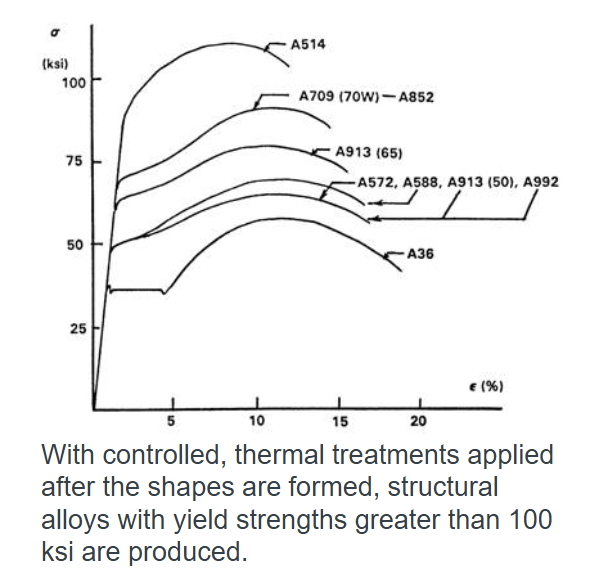
weathering steel
surface oxidation
adheres to base metal,
limiting further rusting.

stainless steel
added nickel and chromium
forms self-protecting oxide
layer that provides long
lasting protection against
corrosion
cold-formed steel
deforming steel in its cold state
causes realignment of the steel
crystals and increases its strength.corrugated steel decking (right)
steel studs and joists
high-strength wire for concrete
prestressing strands
open-web steel joists (owsj)
lightweight pre-manufactured
trussesmade from both hot- and cold-
formed componentsdepths range from 8 in. to 6 ft
used for floor support
how do we join steel?
riveting: not widely used today
bolts: faster assembly on site
welding: more cost effective
riveting
white-hot fastener is inserted
through holes in members to be
fastenedfastener is hammered to
produce a head on the plain endas the metal cools, it contracts,
and tightly clamps the steel
membersmostly found in historic
structures. Rarely used in
modern construction
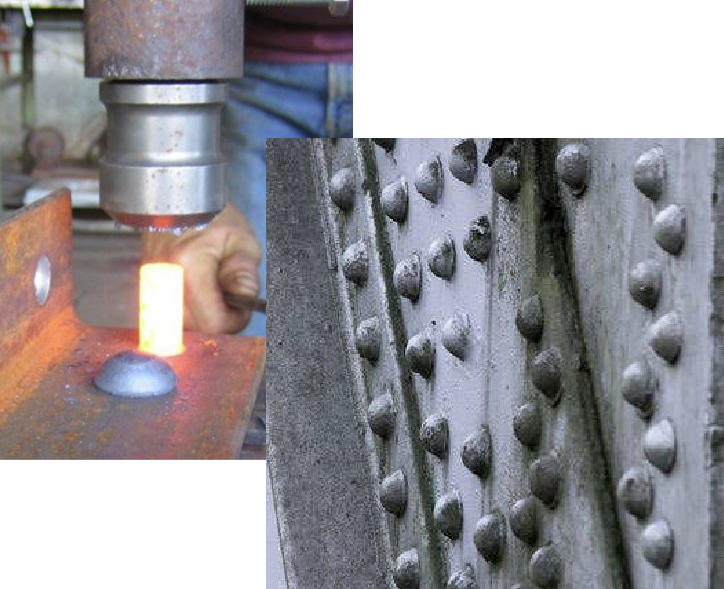
bolted connections: carbon steel bolts
relatively low strength
limited uses, such as fastening
light framing elements or
holding temporary connections
bolted connections: high strength bolts
carbon steel bolts not used
often.instead, we tend to use high-
strength bolts:stronger than common bolts
used for fastening primary
structural members
bearing-type connection
body of bolt resists movement between connected members by bearing directly against sides of bolt holes (left).
bolt is stressed in shear.
connection will slip before it reaches full strength.
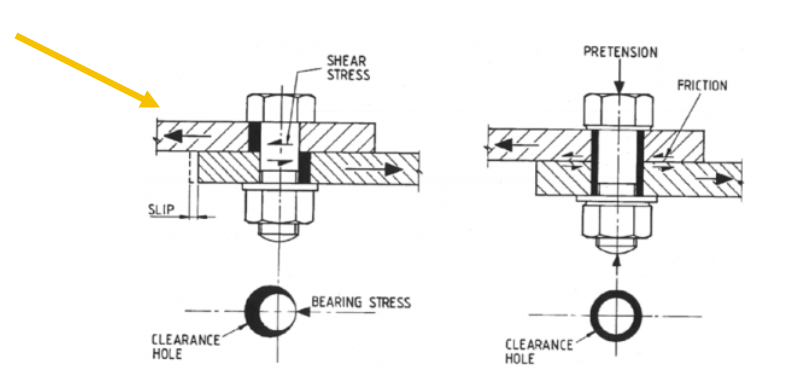
slip-critical connection
bolt is tensioned to such an extent that movement in the joint is resisted
by friction between the adjoining "faying" surfaces of the members
themselves (right).
• bolt is very highly stressed, but in tension.
• no slippage
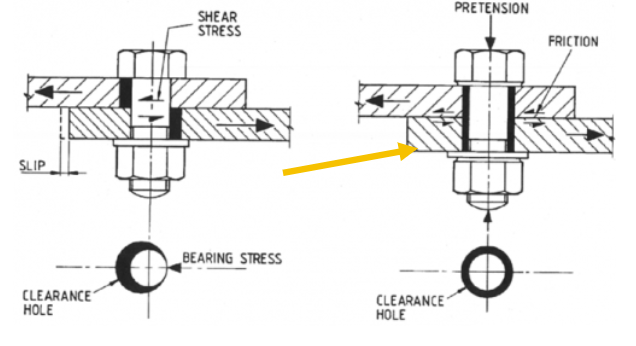
bolt tensioning
with slip-critical connections, proper bolt
tension must be assured.turn-of-nut method: Nut is tightened
some additional fraction of a turn
after achieving a snug condition.
load indicator washers
when bolt is adequately tensioned,
protrusions on the washer are flattened.bolt tension is verified by inserting a gauge between bolt head and washer.

squirt dye for bolt tensioning
some load indicator washers squirt dye
when adequate tension is achieved, making inspection easier
tension control bolt
when bolt is adequately tightened, the splined end snaps off
bolt tension is verified by visually inspecting for splines.
t.c.b. also allow tightening with access to only one side of the bolt.

welding
steel surfaces to be joined are heated to a molten state
additional molten metal is added from the electrode
in finished joint, members are fully fused
welding terms
fillet welds: easy to make, little
joint preparation requiredgroove welds: require properly
shaped and spaced jointspuddle welds: fasten metal
decking to structural members
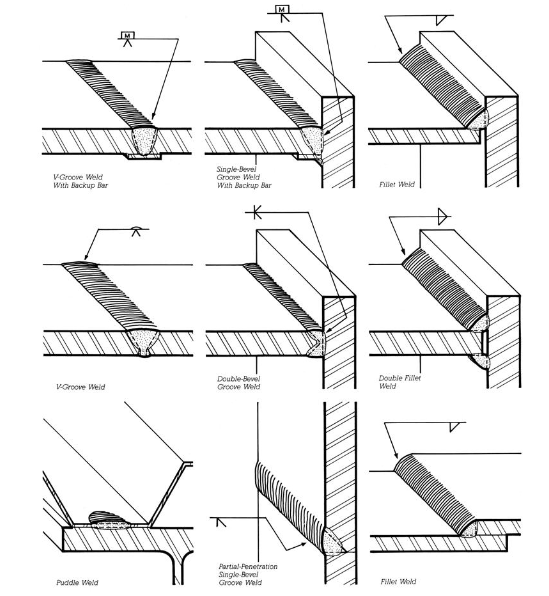
structural stability of welding
welds critical to structural stability may be inspected/tested (ultrasonic, magnetic, etc.) to ensure their soundness and freedom from hidden flaws.
details of steel framing
connection types
shear (simple connection)
moment (fully restrained)
steel frames
braced frame (simple connection)
moment connection (fully restrained)
shear walls
shear connection
angles, plates, or tees connect web of beam to side of column.
angles are usually joined to beam in the fabricator's shop.
beam/angle assembly is bolted to the column in the field
shear connection (simple connection)
transfers gravity loads from beam to columns.
not sufficiently rigid to transfer bending forces.
modeled structurally as if it is free to rotate, or hinged.
AISC Simple Connection (SC)
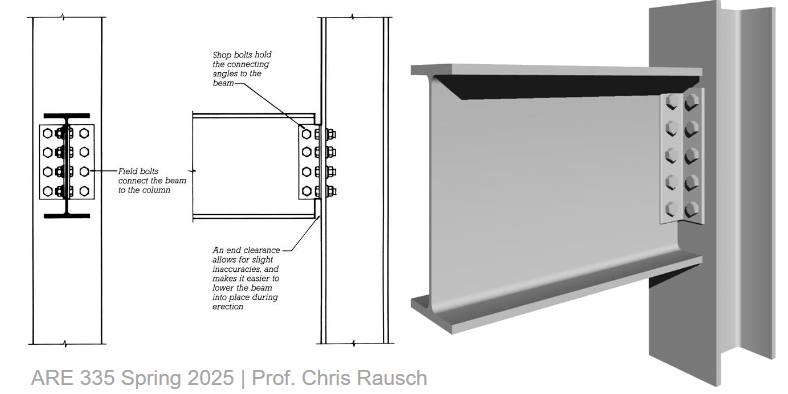
seated connection (shear conn.)
another version of shear connection is a
‘seated connection’ which relies on an angle below the beam and above.this is used when connecting a beam to a column web

moment connections
transfers gravity loads and bending forces.
beam flanges are joined to column.
column is reinforced to carry bending forces.
beam is restrained from even small rotations.
AISC Fully Restrained (FR)
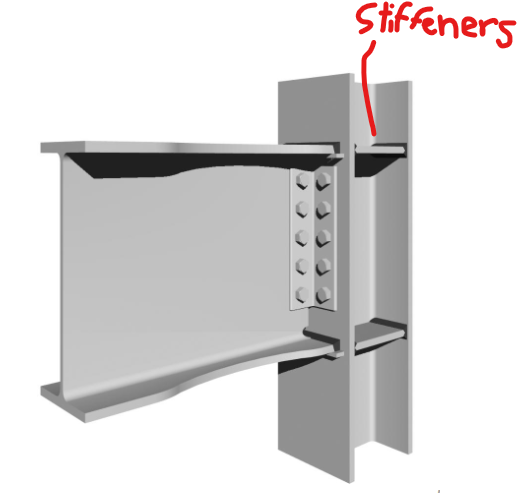
beams/columns in mom. conn.
a pair of beam-column moment
connectionsfull penetration welds join top and bottom beam flanges to column and column reinforcing plates
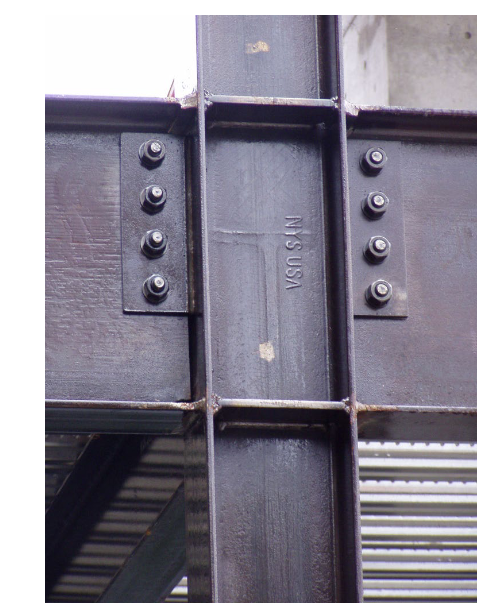
dog bone cut (mom. conn.)
"dog bone" cut creates a zone of weakness.
in extreme seismic event, this area will deform plastically, protecting the more brittle welds from failure.
single common bolt holds beam temporarily prior to welding.
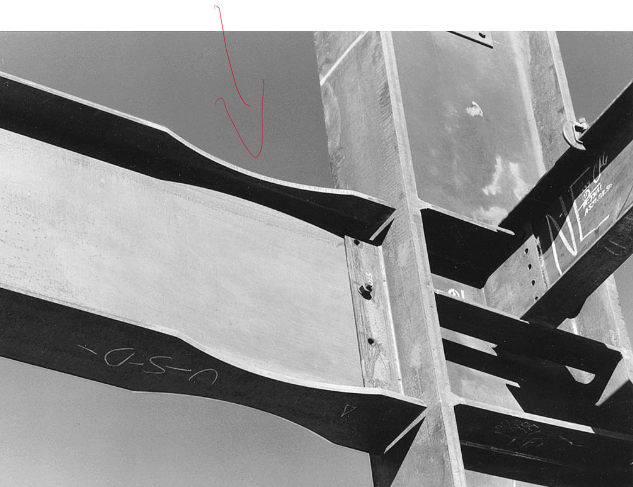
stabilizing building frame
rectangular geometry of the building frame must be made stable against lateral forces by:
diagonal bracing
moment-resisting frame
shear walls

braced frame
diagonal bracing creates stable, triangular geometry
can be constructed with shear connections between beams and columns (free to rotate).

moment resisting frames
some or all of the beam-column connections are moment connections
capable of resisting rotations between the members, making the frame stable
shear walls
rigid vertical walls or core structures resist lateral forces.
remainder of frame relies on shear connections.
usually concrete (occasionally heavy steel plate)
bolted web and welded flanges (connection)
the shear tab is deep enough to position
the bolts clear of the column flanges for easy access.AISC Fully-Restrained (FR)
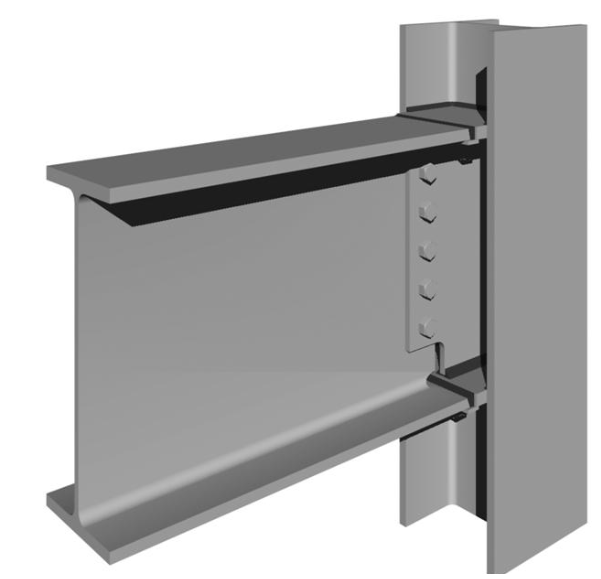
construction process timeline
1. Preparation of Structural Drawings (Structural Engineer)
2. Preparation of Shop Drawings (Fabricator)
a) Detailed fabrication & erection drawings
b) Detail each piece and connections
3. Submission & Approval
4. Order “stock” lengths
5. Fabricate each piece (after Shop Drawing Approval)
6. Ship to Jobsite
7. Erection (Erector)
steel framing plans
shows sizes and locations of
steel membersdimensions have been omitted
from the plan in pic
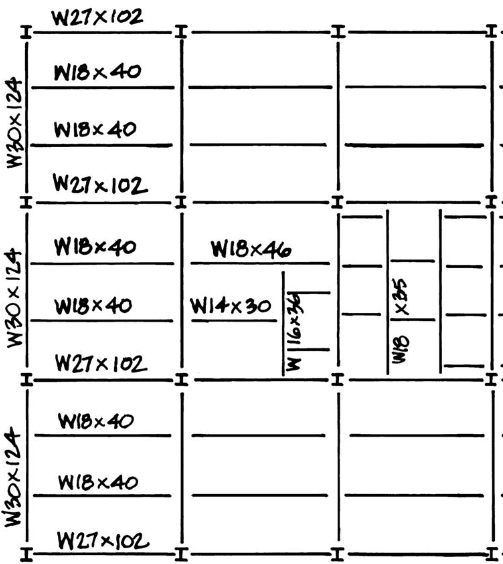
steel framing plans examples
W30 girder-column connection: girder to column flange
W27 beam-column connection: beam to column web
W18 to W30 connection: coped beam-girder

steel detailing and farbication
fabricator makes shop drawings based on contract documents
each component is dimensioned
each connection fully detailed with dimensions of all connection angles, holes, bolt diameters and types of welds
shop or field connections identified
type of bolted connection
after modifications by GC, A & E, materials ordered from rolling mill
components fabricated in shop, shipped to site for erection
fabricator’s role
the fabricator prepares shop drawings showing the configuration of each member.
drawings are reviewed by
architect and structural engineeralso shares responsibility for design of the steel connections, based on more general requirements provided by the structural engineer.
building information modeling
more recently, using bim systems, steel
fabrication information and details
made by the structural engineer in the building model can replace fabricator shop drawings.
steel fabricator
fabricator prepares steel members and delivers them to the construction site
workers cut to length, cope, drill, punch, weld, and add tabs, angles, plates and other accessories to members from the approved shop drawings.
band saw cuts heavy members to size
fabricated members are stacked using overhead crane, awaiting transportation to the construction site
members are individually labeled to correspond to information on the erection drawings.
steel erector
assembles steel members delivered to the construction site.
may or may not be same entity
as fabricator.workers are called ironworkers
steel frame erection sequence
erect columns
install beams and girders
plumb structure
complete (weld or tighten) all connections - including diagonal bracing
install edge angles & decking
start next tier
cranes used for steel frame erection
mobile, tower, and climbing cranes
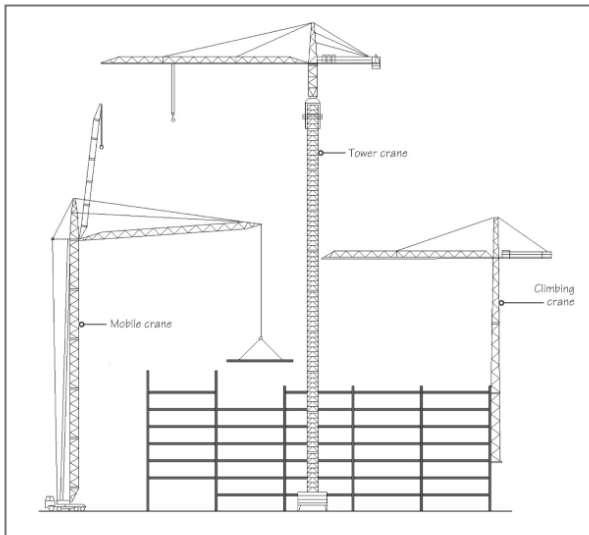
structural steel erection (1st tier columns)
column base plate
distribute loads
attachment to fdn.
often shop welded
holes must match
anchor bolts in ftg
coulmn set to proper elevation
Options:
Leveling Plate
set in grout prior to column erection
Leveling Nuts
nuts set to elevation prior to steel erection
Shims
metal shims set to proper elevation
plumbing structures
as the frame is erected, temporary cables with turnbuckles are used to plumb up (make vertical) the frame.
steel decking
corrugated steel decking laid over
the framing is the most common
floor and roof decking material.the decking is puddle welded to
framing memberssteel decking comes in a variety of
profiles and depths to suit different
load and span conditions.
metal decking attachments
mechanical fastener (self-tapping screws)
welding (common for floor deck)
shear studs
welded to tops of beams, through metal decking
once concrete is poured, the beams, decking, and concrete act together structurally as another form of composite construction

composite metal decking
functions as formwork for concrete and steel reinforcement
often in combination w/ shear studs
creates a shear connection between
deck & frameincreases carrying capacity
produces lighter, stiffer, & less costly
frame
fireproofing
above roughly 500-600 F,
steel rapidly looses strengthfireproofing acts as insulation, protecting steel from the heat of fire

fireproofing materials
concrete
plaster
gypsum board
gypsum wallboard
spray-applied insulation
loose insulation within
column cover
spray-applied fire resistive material (sfrm)
most common approach
to achieve an equal level of protection, lighter members need more insulation than heavier ones, since lighter members heat up more quickly
spray-applied fireproofing, in progress, applied to framing in a steel high rise structure (in pic) (thickness is greater on columns)
metal decking does not require additional fire protection
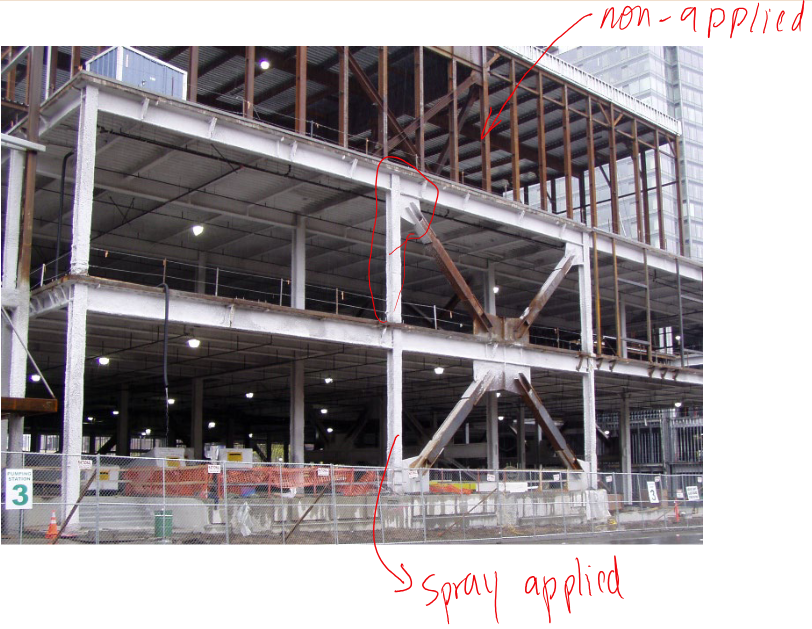
steel & building codes
without fire protection:
building heights & areas severely limited
with proper fire protection:
unlimited building heights & areas permitted for most occupancy groups
corrosion: 2 basic causes
ferrous metals oxidize rapidly when exposed to moisture, salt, chemicals
galvanic action between different metals
corrosion protection approaches
stainless steel (Type 316) should be used in critical exposures/applications
isolate/insulate incompatible metals
e.g., plastic washers
rust-inhibitive protective coatings
reduce ambient moisture & humidity; increase local air circulation
sacrificial galvanic anodes (temporary/time based)
corrosion protection approaches (temp. & perm.)
temporary protection
prime coat (red-brown color)
permanent protection (method varies with environment, and type of steel)
large exposed structural steel
acrylic, epoxy
polyurethane coating most permanent for exterior application
cold formed or light structural steel
galvanizing (zinc coating metallurgically bonded to steel)
early detection of corrosion: how?
currently, when accessible, via E-M
current & ultrasound technologiesbeing studied:
fiber optics
“smart paint” which changes color in the presence of corrosion
sensors